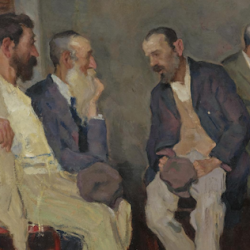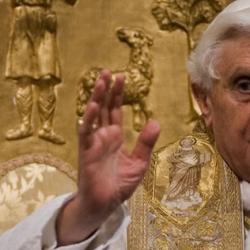Robert Jenson writes: “our enjoyment of God is that we are taken into the triune singing. Perhaps we may say we are allowed to double the parts. And here too we must insist on concreteness. That the proclamation and prayer of the church regularly bursts into beauty, indeed seems to insist on music and choreography and setting, is not an adventitious hankering to decorate. A congregation singing a hymn of praise to the Father is doubling the Son’s praise, and the surge of rhythm and melody is the surge of the Spirit’s glorification of the Father and the Son” (Systematic Theology, 1.235).
In song, we are caught up into the divine communion, and we become united to one another. We are made members of one another, harmonizations each on each.
Singing is in this regard different from speech. In speech, there is a mobile rhythm from subject to object and back. To speak to one another, we have to be willing to take these different positions at different moments.
Song has a different phenomenology. As Christopher Page has put it, “song has the power to abolish the familiar distinction between speaker and interlocutor established by speech.” We can see the difference in the distinction between singing to oneself, which is “regarded as a sign of insouciance,” and talking to oneself, which is “popularly construed as the first mark of madness” (40). Pitch may be the key difference: Music’s “organized and stabilized frequencies somehow [work] against the analytical categories of you and me established in speech” (The Christian West and Its Singers, 40).
Victor Zuckerkandl makes a similar point: “People sing to make sure, through direct experience, of their existence in a layer of reality different from the one in which they encounter each other and things as speakers, as facing one another and separate from one another – in order to be aware of their existence in a place where distinction and separation of man and man, man and thing, thing and thing, gives way to unity, to authentic togetherness” (quoted 40). Where, in short, a world of I, you, it yields to “we.”
Page claims, with disappointment, that early Christian writers paid little attention to this effect of song, but he does cite a passage from Ignatius’s epistle to the Ephesians where communal life is described in thoroughly musical terms:
“It is fitting for you to run together in harmony with the mind of the bishop, which is exactly what you are doing. For your presbytery, which is both worthy of the name and worthy of God, is attuned to the bishops as strings to the lyre. Therefore Jesus Christ is sung in your harmony and symphonic love (sumphonoi agapei). And each of you should join the chorus, that by being symphonic in your harmony, taking up the divine inflection together, you may sing in once voice through Jesus Christ to the Father, that he may both hear and recognize you through the things you do well, since you are members of his Son. Therefore it is useful for you to be in a flawless unison, that you may partake of God at all times as well” (quoted, 41).
Page suggests that the reference to members (mele) is a pun on “melodies”: To be a member of the body of Christ is to be a melody in his song.
Ignatius is not talking about music, not directly. But the metaphor eventually seems to morph into a literal song, the voice of the church singing through Christ to the Father, so that the Lord will hear and recognize and show favor. Yet it’s not clear if he has actual singing in mind: Perhaps he remains within the realm of metaphor, in which case the life of the body becomes itself a kind of music, a sacrifice of praise that ascends to the Father in the Son.











